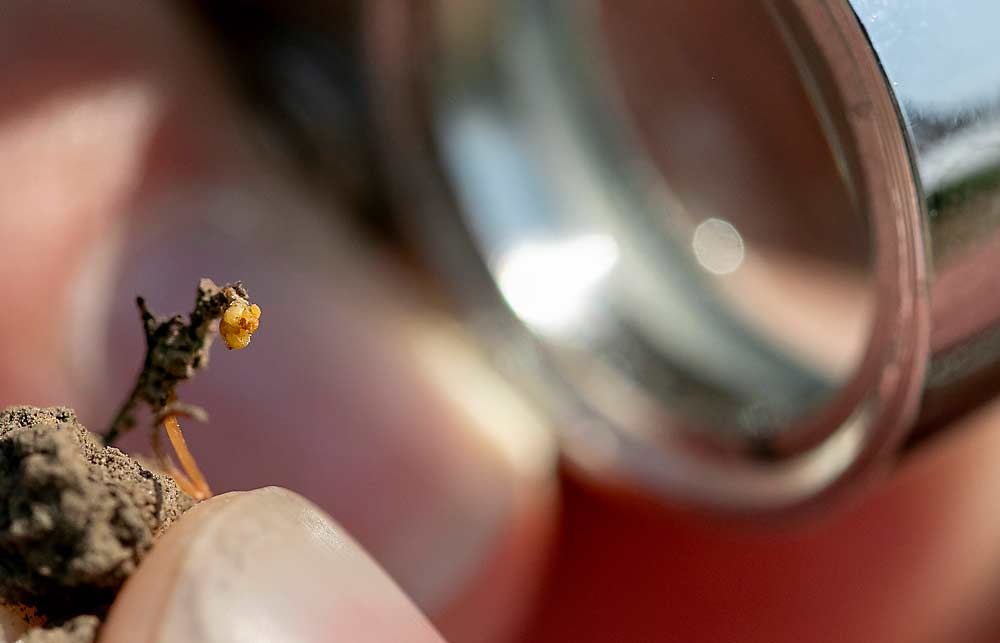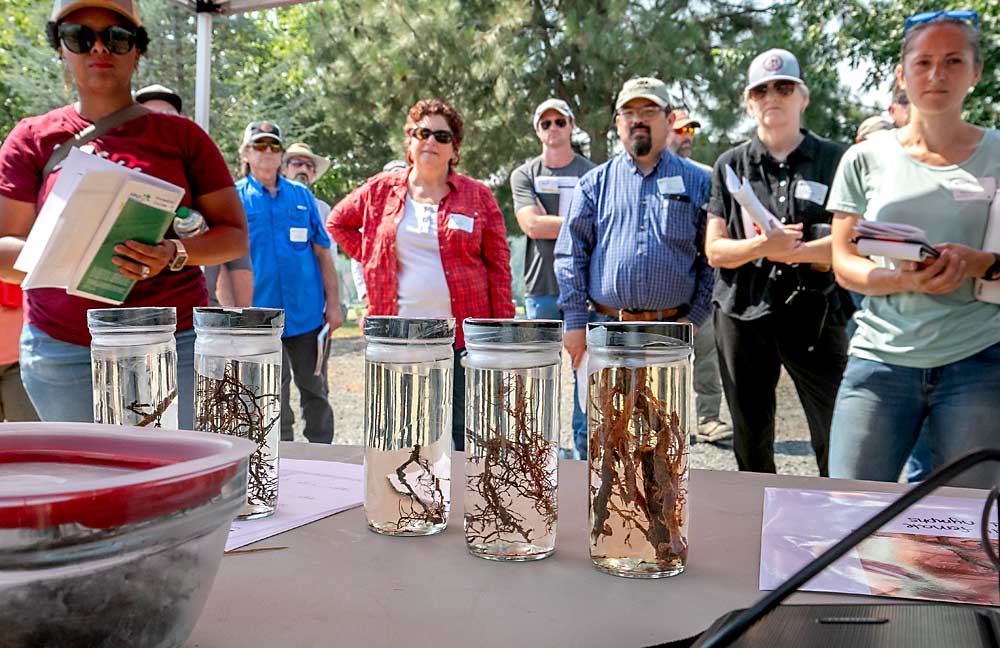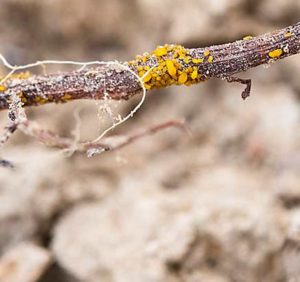—story by Kate Prengaman
—photos by TJ Mulllinax

You won’t find phylloxera at the scene of the crime.
The root-feeding insect can cause severe decline in own-rooted grapevines, but by the time severe symptoms appear in the canopy, digging under the vines will only uncover the evidence: stunted roots.
The culprits, however, have moved on to greener pastures.
“Phylloxera like to feed on healthy roots, so we go to the worst spot in the vineyard and then go to healthy-looking vines nearby,” said Michelle Moyer, professor and viticulture extension specialist at Washington State University, as she explained how to scout for evidence of infestation.
Viticulturist Jason Magnaghi believes this is why it took him years to realize phylloxera were the driving force behind the health declines at Figgins Estate Vineyard in Walla Walla.
“We always looked in the worst places, but we couldn’t find anything (definitive),” he said. The roots, however, looked terrible, with none of the fine roots that do most of the work with water and nutrient absorption. Now, he knows that’s a hallmark trait. “If I’d known what I was looking for, I could have found it 10 years ago.”
Instead, he found proof of phylloxera five years ago and was one of the first growers to sound the alarm that Washington’s vineyards weren’t as immune as many had believed. “It’s not just a Walla Walla problem,” Moyer said, adding that she has identified the pest in samples from American Viticultural Areas around the state.
To help others in the industry learn what to watch for, Magnaghi and vineyard owner Chris Figgins invited the Washington State Grape Society and WSU to host a field day at the vineyard and give attendees an up-close look at phylloxera damage.
In many vineyards now finding phylloxera, the symptoms have likely gone under the radar for decades, Moyer said.
Growers often say that infested blocks were their best block five to 10 years ago, she said. That’s likely because the root damage was providing “free canopy management” until it became more severe.

Finding phylloxera
To find a root-feeding pest, go where the roots are. WSU Extension’s Gwen Hoheisel led attendees on a digging expedition in the sandy soil beneath the drip emitters.
Under the most severely stunted vines, the soil was loose, with only some structural roots and no lateral or fine roots to be found. “It’s amazing what the vines can survive on,” Hoheisel said.
Several vines down the row, supporting a better-looking but still sparse canopy, field day attendees dug up root samples that had more fine roots but also showed the telltale galls formed after phylloxera feeding — visible to the naked eye if you know what to look for. They look like “mouse droppings,” Moyer said, simultaneously apologizing for and defending the effective analogy. The galls start cream-colored but dry to brown.
Farther down the row, under healthy-looking vines, the group uncovered robust roots and the phylloxera themselves. Several life stages of the aphid-like insect can be present at once, looking like “tiny footballs” in different shades of yellow to light brown. A hand lens, 20x or 30x, should help in detection.
In addition to looking in the right place, you need to look at the right time, Moyer said. Phylloxera don’t like the heat and head deeper into the soil in high summer. The best time to scout is early fall when soil cools, she said, or late spring.
“An absence of phylloxera doesn’t mean it’s not there,” she said.

Managing phylloxera
Because growers are finding the pest around the state, Moyer recommends proactive strategies to prevent the spread.
“When you move dirt, you can move phylloxera,” she said.
Everyone at the field day put on disposable boot covers to prevent taking home any souvenirs. She recommends them for people who routinely visit multiple vineyards. Growers should also carefully clean boots and equipment, including tractor or ATV tires and the underside of vine cultivators and bins.
After finding phylloxera, growers ask about management options, Moyer said. Her response is simple.
“Insecticides are Band-Aids,” she said. “The solution is rootstocks.”
Because there is a well-studied solution — growers have been grafting V. vinifera to rootstocks with the resistance of native North American grapevines for over a century — little grant money is available for other aspects of phylloxera research, such as its life cycle in Washington, she added.
While several insecticides are labeled for phylloxera, they do not clean up the pest, they only suppress it.
“Over the years, we’ve been unconsciously suppressing phylloxera with imidacloprid sprayed to control mealybugs,” she said. Once vines have severely declined, insecticides can’t do much, she added, so your best bet is to use them early on.
Magnaghi said that using insecticides, boosting irrigation and nutrition, and removing cover crops to reduce competition “just slows the inevitable” and buys the estate vineyard time to execute its replanting plan. Over the next 10 years, the 30-acre vineyard will be replanted entirely onto rootstocks.
“I will never plant another own-rooted vine, ever,” Magnaghi said. “When you are pulling out 10-year-old vineyards, it’s painful.” •







Leave A Comment